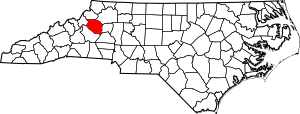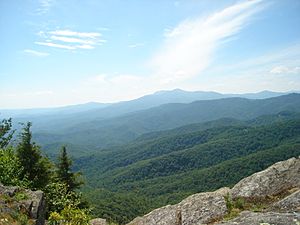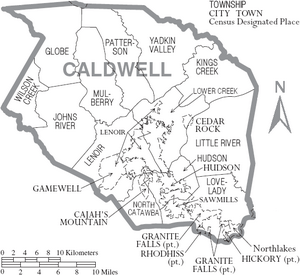Caldwell County, North Carolina facts for kids
Quick facts for kids
Caldwell County
|
|||||
|---|---|---|---|---|---|

Caldwell County Courthouse in Lenoir
|
|||||
|
|||||
| Nickname(s):
The Gateway To The Blue Ridge
|
|||||

Location within the U.S. state of North Carolina
|
|||||
 North Carolina's location within the U.S. |
|||||
| Country | |||||
| State | |||||
| Founded | 1841 | ||||
| Named for | Joseph Caldwell | ||||
| Seat | Lenoir | ||||
| Largest community | Lenoir | ||||
| Area | |||||
| • Total | 474.61 sq mi (1,229.2 km2) | ||||
| • Land | 471.89 sq mi (1,222.2 km2) | ||||
| • Water | 2.72 sq mi (7.0 km2) 0.57% | ||||
| Population
(2020)
|
|||||
| • Total | 80,652 | ||||
| • Estimate
(2023)
|
80,574 | ||||
| • Density | 170.91/sq mi (65.99/km2) | ||||
| Time zone | UTC−5 (Eastern) | ||||
| • Summer (DST) | UTC−4 (EDT) | ||||
| Congressional districts | 5th, 10th | ||||
Caldwell County is a county in the state of North Carolina, USA. It is found in the foothills of the beautiful Blue Ridge Mountains. In 2020, about 80,652 people lived here. The main town and county seat is Lenoir. Caldwell County is part of a larger area called the Hickory-Lenoir-Morganton Metropolitan Statistical Area.
Contents
History
Caldwell County was created in 1841. It was formed from parts of two other counties: Burke County and Wilkes County. The county was named after Joseph Caldwell. He was an important person who served as the first president of the University of North Carolina at Chapel Hill.
Over the years, parts of Caldwell County were used to create other new counties. For example, in 1847, parts of Caldwell, Iredell, and Wilkes counties formed Alexander County. Later, in 1849, parts of Caldwell, Ashe, Wilkes, and Yancey counties helped create Watauga County. This happened a few more times, showing how the map of North Carolina changed over time.
Geography
Caldwell County covers about 474.61 square miles. Most of this area, about 471.89 square miles, is land. The rest, about 2.72 square miles, is water.
The county has three main types of land. In the north and west, you'll find the tall Blue Ridge Mountains. The middle and southern parts have gently rolling hills, which are part of the Piedmont region. In the eastern part, there are the Brushy Mountains. These are smaller mountains, sometimes called the "Brushies." Hibriten Mountain, near Lenoir, is at the western end of this range. The Wilson Creek area is a beautiful spot in the western part of the county.
National Protected Areas
- Blue Ridge Parkway (a scenic road)
- Pisgah National Forest (a large forest)
State and Local Protected Areas
- Backbone Ridge State Forest
- Buffalo Cove Game Land
- Grandfather Mountain State Park
- Pisgah National Forest Game Land
- Pisgah (WRC) Game Land
- Tuttle Educational State Forest
Major Water Bodies
- Beaver Creek
- Blue Creek
- Catawba River
- Gunpowder Creek
- Husband Creek
- Johns River
- Lake Hickory
- Little Gunpowder Creek
- Little King Creek
- Lower Creek
- Mill Creek
- Mulberry Creek
- Rhodhiss Lake
- Rock Creek
- Silver Creek
- Upper Little River
- Wilson Creek
- Yadkin River
Adjacent Counties
- Watauga County – to the north
- Wilkes County – to the northeast
- Alexander County – to the east
- Catawba County – to the southeast
- Burke County – to the south
- Avery County – to the west
Major Highways
 US 64
US 64 US 221
US 221 US 321 (This is the busiest highway in the county!)
US 321 (This is the busiest highway in the county!) US 321A
US 321A NC 18
NC 18 NC 90
NC 90 NC 268
NC 268
Major Infrastructure
- Caldwell County has one railroad, the Caldwell County Railroad.
- Foothills Regional Airport (partially in Burke County)
Demographics
| Historical population | |||
|---|---|---|---|
| Census | Pop. | %± | |
| 1850 | 6,317 | — | |
| 1860 | 7,497 | 18.7% | |
| 1870 | 8,476 | 13.1% | |
| 1880 | 10,291 | 21.4% | |
| 1890 | 12,298 | 19.5% | |
| 1900 | 15,694 | 27.6% | |
| 1910 | 20,579 | 31.1% | |
| 1920 | 19,984 | −2.9% | |
| 1930 | 28,016 | 40.2% | |
| 1940 | 35,795 | 27.8% | |
| 1950 | 43,352 | 21.1% | |
| 1960 | 49,552 | 14.3% | |
| 1970 | 56,699 | 14.4% | |
| 1980 | 67,746 | 19.5% | |
| 1990 | 70,709 | 4.4% | |
| 2000 | 77,415 | 9.5% | |
| 2010 | 83,029 | 7.3% | |
| 2020 | 80,652 | −2.9% | |
| 2023 (est.) | 80,574 | −3.0% | |
| U.S. Decennial Census 1790–1960 1900–1990 1990–2000 2010 2020 |
|||
2020 Census
| Race | Number | Percentage |
|---|---|---|
| White (not Hispanic) | 67,868 | 84.15% |
| Black or African American (not Hispanic) | 3,843 | 4.76% |
| Native American | 196 | 0.24% |
| Asian | 527 | 0.65% |
| Pacific Islander | 15 | 0.02% |
| Other/Mixed | 3,280 | 4.07% |
| Hispanic or Latino | 4,923 | 6.1% |
In 2020, there were 80,652 people living in Caldwell County. There were 32,513 households and 20,975 families.
Education
Caldwell County has many schools for students of all ages.
Elementary Schools
- Baton
- Davenport
- Dudley Shoals
- Gamewell
- Granite Falls
- Hudson
- Lower Creek
- Sawmills
- Valmead
- West Lenoir
- Whitnel
K-8 Schools
- Collettsville
- Happy Valley
- Kings Creek
- Oak Hill Charter School
Middle Schools
- Gamewell
- Granite Falls
- Hudson
- William Lenoir
High Schools
- Caldwell Applied Sciences Academy
- Caldwell Early College
- Hibriten
- South Caldwell
- West Caldwell
Alternative Schools
- Horizons Elementary
- Gateway School
Private Schools
- Heritage Christian School (for grades K-12)
Independent School
- Moravian Prep
College
- Caldwell Community College & Technical Institute
- Appalachian State University Center at Caldwell (a place for distance learning from Appalachian State University)
Communities
Caldwell County has several different types of communities.
City
- Lenoir (This is the county seat and the biggest community.)
Towns
Village
Census-Designated Place
Other Unincorporated Communities
- Abingdon
- Baton
- Collettsville
- Dudley Shoals
- Patterson
- Globe
- Grace Chapel
- Grandin
- Happy Valley
- Kings Creek
- Legerwood
- Mortimer, North Carolina
- Mulberry
- Warrior
- Yadkin Valley
Townships
Townships are smaller areas within the county. In Caldwell County, they include:
- Globe
- Hudson
- Johns River
- Kings Creek
- Lenoir
- Little River
- Lovelady
- Lower Creek
- Mullberry
- North Catawba
- Patterson
- Wilson Creek
- Yadkin Valley
See also
 In Spanish: Condado de Caldwell (Carolina del Norte) para niños
In Spanish: Condado de Caldwell (Carolina del Norte) para niños






